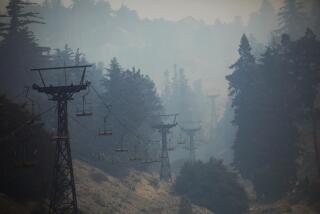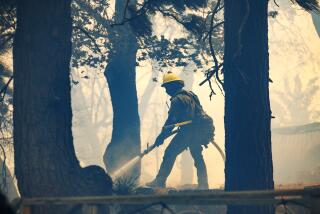Reality check for beginning skiers
Call it a mini-crisis. It was my fourth day of skiing — ever — and Vail Mountain was getting pounded with snow.
Standing at the base, I watched my buddies charge hard for the iconic back bowls. As a newbie and still unsure on skis, I struggled to make sense of the trail map with its spider web of green, blue and black runs.
“Big day for powder,” someone in the lift line said.
Another guy told his friend, “Not a great day to learn how to ski.”
True on both counts. Because Vail is so large and I wasn’t sure where the terrain and my skill level coincided, I was frustrated much of the day, although I still count it as a success. But as I developed into a skier, I realized that navigating a mountain is more than just memorizing a trail map.
The real skill is the ability to assess terrain and mountain infrastructure and relate it to your skiing ability.
“Skiing a mountain can be intimidating,” Vail ski patroller Chris Reeder told me recently while we huddled next to a mid-mountain fireplace as a blizzard raged outside. “Especially a mountain for the first time.”
The 5,239 acres of Vail are a good example. The resort has 31 lifts that service 193 conventional trails. Fifty-three percent of the trails are expert or advanced, 29% intermediate and 18% beginner. Add in the mountain’s seven bowls, and you have virtually an infinite number of runs, thanks to the wide-open terrain.
“I’ve been skiing at Vail for years, and I still find new stuff,” longtime Vail resident Jack Hunn told me. “The mountain just has so many ways to get around.”
That brings me back to standing alone as the snow piled up faster than I would have liked. New skiers and those who might be looking at the mountain for the first time can easily become overwhelmed as they try to choose the best runs without getting in over their heads.
With each season I learned the art of skiing (or boarding) was more than just showing up and heading to a favorite run. It is about choosing the ideal way to approach the mountain to get fresh powder in the morning, untouched stashes by lunchtime and to avoid ice during the afternoon.
Then there is the art of avoiding the half-hour lines that form around well-used lifts that inexperienced skiers use. (These are usually the same people who have trouble getting on and off the lifts).
“Many times people don’t think about what went into all the infrastructure and planning of a resort and how it helps them get around the mountain,” said Kent Sharp of the ski resort design firm SE Group.
Before I got into skiing, I also never imagined that I would be chatting about the fine art of grooming styles, lift placements, fall lines and the not-so-subtle differences between fixed and detachable lifts.
First, let’s talk about the lifts. Both types — fixed and detachable — put skiers on the mountain, but they do so in a slightly different way.
Take, for example, this year’s new high-speed lift at Arapahoe Basin, a resort on the Continental Divide in Colorado.
The old fixed lift, which operated by using only one cable to move skiers up and down the mountain, caused bottlenecks and skier error, mostly with the beginner and intermediate ski crowd. The one-cable system meant skiers were loaded and unloaded at the same speed at which they were transported up the mountain. Essentially if the chair was moving at a speed of 500 feet per second, skiers had to be comfortable navigating the load/unload process with a chair moving that fast.
Here’s the rub: At Arapahoe Basin (and many other resorts with fixed lifts) skiers want to spend as little time as possible on the lift, but not all skiers can load and unload safely if the cable is moving that fast.
The solution? Slow down the cable speed enough to make it safe and easy for skiers to get on and off without unduly delaying the trip up the slope.
“It’s a juggling act,” Sharp said.
Thus the new high-speed detachable lifts, which are prevalent at resorts today, use two separate cables. That means chairs can be transferred to a slower-moving cable at the loading and unloading zones, allowing the skiers to load at a speed that differs from their ascent speed.
“Because detachable lifts are so much easier to load and unload for people learning to ski,” Alan Henceroth, vice president and chief operating officer for Arapahoe Basin, wrote in an early-season blog post, “we anticipate way fewer stops and slows.”
As for lift placement, resorts rely on repeat business, so they feel pressure to open new terrain. But, Hunn noted, “It’s easy to get lost or spend lots of time on moving around a mountain. Knowing how to read terrain and what type of a lift services it is what helps.”
Experts say new skiers should rely less on trail designations and more on their assessment of their own abilities (assuming their view is realistic). A quick look at Vail’s map, for instance, shows that a beginning skier can get to the top of the mountain but not into the back bowls on a beginner run.
There are intermediate runs that can take you there if you are comfortable doing so and think it’s a manageable risk. As in most things in life, honesty with oneself is key, as is seeking advice.
“One of the best things new skiers can do is ask for help,” Reeder told me. “I enjoy it when someone asks how to get somewhere.”
Other tricks to navigating a resort include choosing a section of the mountain that is served by one lift but offers a range of terrain. That way, groups can stay together while new skiers take easier runs down and more advanced skiers take steeper trails.
Then there is the ultimate resource for skiers wanting to learn the small stuff about a new resort or favorite local hill. This document, known as a master plan, deconstructs why a tree island may have been left in the middle of a favorite run or why a particular lift is where it is.
Buried deep inside hundreds of pages, a skier or boarder can find a slew of information about how the mountain comes together. Some of the information includes fall line analysis, usually considered the fastest way down a mountain and determined by the line a ball would roll if rolled down the trail; slope analysis, which measures the gradient of each potential trail; and a snow analysis, which maps the snow collection each trail may have and how winds and weather patterns change the snow pack.
To access a master plan, contact the resort’s media or public relations department. It may take a bit of sleuthing, but it’s worth it.
“Skiing is a journey,” Hunn said. “Some days I just go out and ride lifts, while other days I focus hard on skiing. But one thing stays the same. I love to be out there regardless.
“Just be ready to have fun and be challenged.”
More to Read
Sign up for The Wild
We’ll help you find the best places to hike, bike and run, as well as the perfect silent spots for meditation and yoga.
You may occasionally receive promotional content from the Los Angeles Times.






